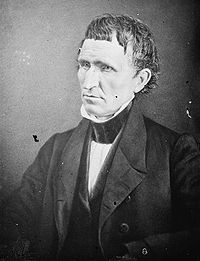George McDuffie
| George McDuffie | |
|---|---|
 |
|
|
United States Senator from South Carolina |
|
|
In office December 23, 1842 – August 17, 1846 |
|
| Preceded by | William C. Preston |
| Succeeded by | Andrew Butler |
| 55th Governor of South Carolina | |
|
In office December 9, 1834 – December 10, 1836 |
|
| Lieutenant | Whitemarsh B. Seabrook |
| Preceded by | Robert Y. Hayne |
| Succeeded by | Pierce Mason Butler |
| Member of the U.S. House of Representatives from South Carolina's 5th district |
|
|
In office March 4, 1823 – 1834 |
|
| Preceded by | Starling Tucker |
| Succeeded by | Francis W. Pickens |
| Member of the U.S. House of Representatives from South Carolina's 6th district |
|
|
In office March 4, 1821 – March 3, 1823 |
|
| Preceded by | Eldred Simkins |
| Succeeded by | John Wilson |
| Member of the South Carolina House of Representatives from the Edgefield District | |
|
In office November 23, 1818 – November 27, 1820 |
|
| Personal details | |
| Born |
August 10, 1790 Columbia County, Georgia |
| Died | March 11, 1851 (aged 60) Sumter District, South Carolina |
| Political party | Democratic |
| Other political affiliations |
Jacksonian, Nullifier |
| Spouse(s) | Mary Rebecca Singleton |
| Profession | Politician, Lawyer |
George McDuffie (August 10, 1790 – March 11, 1851) was the 55th Governor of South Carolina and a member of the United States Senate.
Born of modest means in Columbia County, Georgia, McDuffie's extraordinary intellect was noticed while clerking at a store in Augusta, Georgia. The Calhoun family sponsored his education at Moses Waddel's famous Willington Academy, where he established an outstanding reputation. Graduating from South Carolina College in 1813, he was admitted to the bar in 1814, and went into partnership with Eldred Simkins at Edgefield. Rising rapidly, he served in the South Carolina General Assembly in 1818–1821, and in the United States House of Representatives in 1821–1834. In 1834 he became a major general of the South Carolina Militia.
In 1821 he published a pamphlet in which strict states' rights were strongly denounced; yet in 1832 he became one of the greater nullifiers. The change seems to have been gradual, and to have been determined in part by the influence of John C. Calhoun. When, after 1824, the old Democratic-Republican party split into factions, he followed Andrew Jackson and Martin Van Buren in opposing the Panama Congress and the policy of making Federal appropriations for internal improvements. He did not hesitate, however, to differ from Jackson on the two chief issues of his administration: the Bank and nullification.
In 1832 he was a prominent member of the South Carolina Nullification Convention, and drafted its address to the people of the United States. He served as governor in 1834–1836, during which time he helped to reorganize South Carolina College. From January 1843 until January 1846 he was a member of the United States Senate. The leading Democratic measures of those years all received his hearty support. McDuffie, like Calhoun, became an eloquent champion of state sovereignty; but while Calhoun emphasized state action as the only means of redressing a grievance, McDuffie paid more attention to the grievance itself. Influenced in large measure by Thomas Cooper, he made it his special work to convince the people of the South that the downfall of protection was essential to their material progress. In opposing the 1828 Tariff of Abominations he used the illustration that forty bales of every one hundred went to pay tariffs and therefore Northern interests. His argument that it is the producer who really pays the duty of imports has been called the economic basis of nullification.
...
Wikipedia
